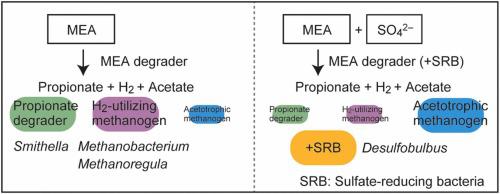Journal of Hazardous Materials ( IF 12.2 ) Pub Date : 2022-08-12 , DOI: 10.1016/j.jhazmat.2022.129764 Yasuyuki Takemura 1 , Masataka Aoki 1 , Tsuyoshi Danshita 2 , Akinori Iguchi 3 , Shoji Ikeda 4 , Yuma Miyaoka 1 , Haruhiko Sumino 5 , Kazuaki Syutsubo 6

|
Monoethanolamine (MEA), a toxic organic chemical, is widely used in industries and is found in their wastewater. Anaerobic MEA degradation is an appropriate strategy to reduce energy and cost for treatment. Industry wastewaters also contain sulfate, but information on the effects of sulfate on MEA degradation is limited. Here, an up-flow anaerobic sludge blanket (UASB) for MEA-containing wastewater treatment was operated under psychrophilic conditions (18–20 ºC) to investigate the effects of sulfate on the microbial characteristics of the retained sludge. To acclimatize the sludge, the proportion of MEA in the influent (containing sucrose, acetate, and propionate) was increased from 15% to 100% of total COD (1500 mg L–1); sulfate was then added to the influent. The COD removal efficiency remained above 95% despite the increase in MEA and sulfate. However, granular sludge disintegration was observed when sulfate was increased from 20 to 330 mg L–1. Batch tests revealed that propionate and acetate were produced as the metabolites of MEA degradation. In response to sulfate acclimation, methane-producing activities for propionate and hydrogen declined, while sulfate-reducing activities for MEA, propionate, and hydrogen increased. Accordingly, acclimation and changes in dominant microbial groups promoted the acetogenic reaction of propionate by sulfate reduction.
中文翻译:

硫酸盐浓度对上流式厌氧污泥床反应器厌氧处理含单乙醇胺废水的影响
单乙醇胺 (MEA) 是一种有毒的有机化学物质,广泛用于工业并存在于其废水中。厌氧MEA降解是降低处理能量和成本的适当策略。工业废水也含有硫酸盐,但关于硫酸盐对 MEA 降解影响的信息有限。在这里,用于含 MEA 废水处理的上流式厌氧污泥层 (UASB) 在嗜冷条件 (18-20 ºC) 下运行,以研究硫酸盐对滞留污泥微生物特性的影响。为了使污泥适应环境,进水中的 MEA 比例(含有蔗糖、乙酸盐和丙酸盐)从总 COD 的 15% 增加到 100%(1500 mg L –1); 然后将硫酸盐添加到流入液中。尽管 MEA 和硫酸盐增加,COD 去除效率仍保持在 95% 以上。然而,当硫酸盐从 20 增加到 330 mg L -1时,颗粒污泥分解。批量测试表明,丙酸盐和乙酸盐是作为 MEA 降解的代谢物产生的。响应于硫酸盐驯化,丙酸盐和氢气的产甲烷活性下降,而 MEA、丙酸盐和氢气的硫酸盐还原活性增加。因此,驯化和优势微生物群的变化促进了硫酸盐还原丙酸盐的产乙酸反应。











































 京公网安备 11010802027423号
京公网安备 11010802027423号